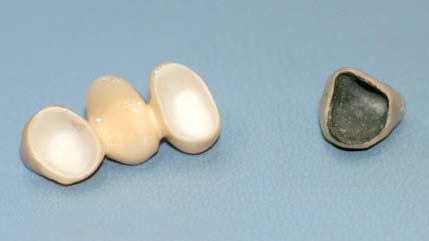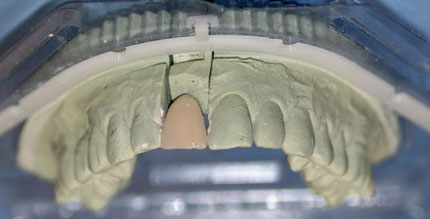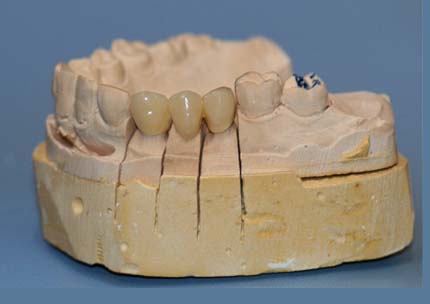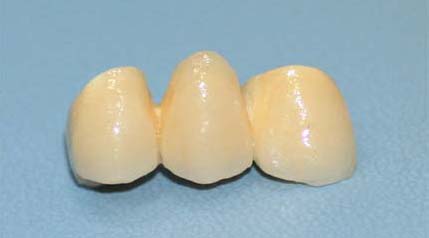There are many types of crowns and bridges; the most common crowns and bridges are ceramic crowns with a metal core. These crowns and bridges are not very attractive, since with the metal inside they seem a bit unreal.
Today though there are many materials to use as a core for crowns and bridges, for example pure porcelain crowns and bridges or even better – the best material around – zirconia.
Zirconia is a white core, it is very strong and makes crowns and bridges look amazingly vivid and realistic.
It is the ultimate choice if you want your crowns and bridges to look like real teeth.

When you lose a tooth and you need to restore the gap that is left there are two options. One is to replace the missing tooth with an implant and the other is to replace the gap with crowns and bridges. The bridge well bridges the gap of the missing tooth connecting the tooth before the gap with the tooth after the gap with full coverage crowns (that is with crowns that cover the tooth fully from all sides). Or perhaps you do not like the appearance of a tooth or it has lost a lot of tissue and you want to protect it with a crown, then you need to decide what crowns and bridges will you put on your tooth.
There are several types of crowns and bridges available: metal crowns, metal-acryllic crowns, metal-ceramic crowns, full ceramic crowns and alumina or zirconia –ceramic crowns.
You can say “this is all Greek to me” and you would be right. So what is the difference between all these types of crowns and bridges and which one is more suitable for each case?
All these questions will be answered in this article.
Metal crowns are not really used any more in dentistry. They maybe rather hard and reliable, but they are really ugly, non-aesthetic and today there is no use for them. Sometimes full coverage crowns and bridges are made of metal only in special cases (most of them for financial reasons).
Metal – acrylic crowns and bridges are still used in dentistry. These crowns have a metal core and are covered on the visible side (meaning that they are not covered with plastic on the inside). They look ok, they are steady enough, and they don’t cost much so where is the catch?
Well the catch is that first of all the material covering the metal is plastic, so in time it will change color and it will start to change its chemical state giving a really unpleasant taste to the mouth; and let’s not forget that there is no actual chemical bond between the metal and the plastic cover (there is only mechanical fixture) so it can even chip or break and leave you with a rather ugly metal window on your teeth.
Metal ceramic crowns and bridges are used most of the time. They are the most preferable type of crown used in dentistry today. And there is no reason why they should not be. Metal ceramic crowns and bridges have a metal core (can be stainless steel or gold plated metals) and the metal is covered with ceramic (porcelain). Here there is a chemical bond between the metal and the porcelain, the material is stable over time, it does not change color neither does it come.
There are of course several drawbacks as for example the chipping of the porcelain if it sustains extreme pressure, there is no way to repair the porcelain loss if the metal is uncovered (if there is no metal visible the missing porcelain chip can be restored in the dentist office very quickly in 20 minutes) and of course metal porcelain crowns and bridges are more expensive than metal or metal – acrylic crowns.

On the other hand though, metal porcelain crowns and bridges are good and rather beautiful but they don’t come even close to the aesthetics of a natural tooth. And that is because of the metal core that is inside them. This metal core has to be covered with an opaque layer of porcelain and that still makes these crowns look rather fake. You can always understand that someone is wearing metal ceramic crowns and bridges.
Today though technology has improved porcelain enough to be used without a metal core and sustain pressure.
Full ceramic crowns and bridges have no metal core, so they look absolutely beautiful and they are really close to the aesthetics of a natural tooth. The drawback is that they can only endure this much pressure making them not suitable for long bridges (many teeth missing) or bridges for posterior teeth that sustain a lot of pressure. Another factor to consider is the price. They cost almost twice or even more than metal-ceramic crowns and bridges.
The latest technology of today regarding crowns and bridges is zirconia – ceramic crowns. Zirconia is a white metal core that is really hard) and of course it gives a very good aesthetic result (if not perfect) since it is white!

Zirconia-ceramic crowns are indeed state of the art, they can endure a lot of pressure, and they can be used for long bridges and for posterior crowns and bridges. Well of course everything good comes at a price. They are even more expensive than full ceramic crowns. But what you pay is what you get.

Which crown is the best?
Well the facts have been given to you; it is up to you to decide which crown you want for your teeth. My money is on the zirconia ceramic crowns and bridges.
No patient of mine who has seen a zirconia ceramic crown ever asked for any other type of crowns and bridges. But don’t let my personal experience influence you.
One popular idea is to have your dental crowns and bridges done before, after or during your holidays in Greece or the Greek islands.
If you would like to learn more on crowns and bridges or if you have questions on the subject please contact one of our listed Greek dental specialists in crowns and bridges.
